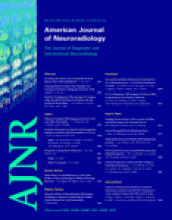Research ArticleBrain
Increased Signal in the Subarachnoid Space on Fluid-Attenuated Inversion Recovery Imaging Associated with the Clearance Dynamics of Gadolinium Chelate: A Potential Diagnostic Pitfall
J.M. Morris and G.M. Miller
American Journal of Neuroradiology November 2007, 28 (10) 1964-1967; DOI: https://doi.org/10.3174/ajnr.A0694

References
- ↵Adams JG, Melhem ER. Clinical usefulness of T2-weighted fluid-attenuated inversion recovery MR imaging of the CNS. AJR Am J Roentgenol 1999;172:529–36
- ↵Noguchi K, Oqawa T, Inugami A, et al. Acute subarachnoid hemorrhage: diagnosis with fluid-attenuated inversion-recovery MR imaging. Radiology 1995;196:773–77
- ↵Singer MB, Atlas SW, Drayer BP. Subarachnoid space disease: diagnosis with fluid–attenuated inversion-recovery MR imaging and comparisons with gadolinium-enhanced spin-echo MR imaging: blinded reader study. Radiology 1998;208:417–22
- ↵Mathews VP, Caldemeyer KS, Lowe MJ, et al. Brain: gadolinium-enhanced fast fluid-attenuated inversion-recovery MR imaging. Radiology 2000;215:922–24
- ↵
- Rumpel H, Chan LL. Serial FLAIR imaging after Gd-DTPA contrast: pitfalls in stroke trial magnetic resonance imaging. Stroke 2003;34:797–98
- ↵Warach S, Latour LL. Evidence of reperfusion injury, exacerbated by thrombolytic therapy, in human focal brain ischemia using a novel imaging marker of early blood-brain barrier disruption. Stroke 2004;35 (11 suppl 1):2659–61. Epub 2004 Oct 7
- ↵Tsuchiya K, Katase S, Yoshino A, et al. FLAIR MR imaging for diagnosing intracranial meningeal carcinomatosis. AJR Am J Roentgenol 2001;176:1585–98
- ↵Singh SK, Leeds NE, Ginsberg LE. MR imaging of leptomeningeal metastases: comparison of three sequences. AJNR Am J Neuroradiol 2002;23:817–21
- ↵Kanamalla US, Baker KB, Boyko OB. Gadolinium diffusion into subdural space: visualization with FLAIR MR imaging. AJR Am J Roentgenol 2001;176:1604–05
- ↵
- ↵Bozzao A, Bastianello S, Bozzao L. Superior sagittal sinus thrombosis with high-signal-intensity CSF mimicking subarachnoid hemorrhage on MR FLAIR images. AJR Am J Roentgenol 1997;169:1183–84
- ↵Villalobos-Chavez F, Rodriguez-Uranga JJ, Sanz-Fernandez G. Sequential changes in magnetic resonance in a limbic status epilepticus. Rev Neurol 2005;40:354–57
- ↵Frigon C, Jardine DS, Weinberger E, et al. Fraction of inspired oxygen in relation to cerebrospinal fluid hyperintensity on FLAIR MR imaging of the brain in children and young adults undergoing anesthesia. AJR Am J Roentgenol 2002;179:791–96
- ↵Kim EY, Kim SS, Na DG, et al. Sulcal hyperintensity on fluid-attenuated inversion recovery imaging in acute ischemic stroke patients treated with intra-arterial thrombolysis: iodinated contrast media as its possible cause and the association with hemorrhagic transformation. J Comput Assist Tomogr 2005;29:264–69
- ↵Lev MH, Schaefer PW. Subarachnoid gadolinium enhancement mimicking subarachnoid hemorrhage on FLAIR MR images: fluid-attenuated inversion recovery. AJR Am J Roentgenol 1999;173:1414–15
- ↵Kanamalla US, Boyko OB. Gadolinium diffusion into orbital vitreous and aqueous humor, perivascular space, and ventricles in patients with chronic renal disease. AJR Am J Roentgenol 2002;179:1350–52
- ↵Maramattom BV, Manno EM, Wijdicks EF, et al. Gadolinium encephalopathy in a patient with renal failure. Neurology 2005;64:1276–78
- ↵Mamourian AC, Hoopes PJ, Lewis LD, et al. Visualization of intravenously administered contrast material in the CSF on fluid-attenuated inversion-recovery MR images: an in vitro and animal-model investigation. AJNR Am J Neuroradiol 2000;21:105–11
- ↵Melhem ER, Jara H, Eustace S. Fluid-attenuated inversion recovery MR imaging: identification of protein concentration thresholds for CSF hyperintensity. AJR Am J Roentgenol 1997;169:859–62
- ↵Bozzao A, Floris R, Fasoli F, et al. Cerebral spinal fluid changes after intravenous injection of gadolinium chelate: assessment by FLAIR MR imaging. Eur Radiol 2003;13:592–97
- ↵Taoka T, Yuh WT, White M, et al. Sulcal hyperintensity on fluid-attenuated inversion recovery MR images in patients without apparent cerebrospinal fluid abnormality. AJR Am J Roentgenol 2001;176:519–24
- ↵Rai A, Hogg JP. Persistence of gadolinium in CSF: a diagnostic pitfall in patients with end-stage renal disease. AJNR Am J Neuroradiol 2001;22:1357–61
- ↵Wilkinson ID, Griffiths PD, Hoggard N, et al. Unilateral leptomeningeal enhancement after carotid stent detected by magnetic resonance imaging. Stroke 2000;31:848–51
- ↵Joffe P, Thomsen HS, Meusel M. Pharmacokinetics of gadodiamide injection in patients with severe renal insufficiency and patients undergoing hemodialysis or continuous ambulatory peritoneal dialysis. Acad Radiol 1998;5:491–502
- ↵Shellock FG, Kanal E. Safety of magnetic resonance imaging contrast agents. J Magn Reson Imaging 1999;10:477–84
- ↵Arsenault TM, King BF, Marsh JW, et al. Systemic gadolinium toxicity in patients with renal insufficiency and renal failure: retrospective analysis of an initial experience. Mayo Clin Proc 1996;71:1150–54
- ↵Grobner, T. Gadolinium: a specific trigger for the development of nephrogenic fibrosing dermopathy and nephrogenic systemic fibrosis? Nephrol Dial Transplant 2006;21:1104–8
In this issue
Advertisement
J.M. Morris, G.M. Miller
Increased Signal in the Subarachnoid Space on Fluid-Attenuated Inversion Recovery Imaging Associated with the Clearance Dynamics of Gadolinium Chelate: A Potential Diagnostic Pitfall
American Journal of Neuroradiology Nov 2007, 28 (10) 1964-1967; DOI: 10.3174/ajnr.A0694
0 Responses
Jump to section
Related Articles
- No related articles found.
Cited By...
- HARMless: Transient Cortical and Sulcal Hyperintensity on Gadolinium-Enhanced FLAIR after Elective Endovascular Coiling of Intracranial Aneurysms
- Flat Detector Angio-CT following Intra-Arterial Therapy of Acute Ischemic Stroke: Identification of Hemorrhage and Distinction from Contrast Accumulation due to Blood-Brain Barrier Disruption
- Elevated Cerebral Blood Volume Contributes to Increased FLAIR Signal in the Cerebral Sulci of Propofol-Sedated Children
- Isolated Acute Nontraumatic Cortical Subarachnoid Hemorrhage
This article has not yet been cited by articles in journals that are participating in Crossref Cited-by Linking.
More in this TOC Section
Similar Articles
Advertisement











